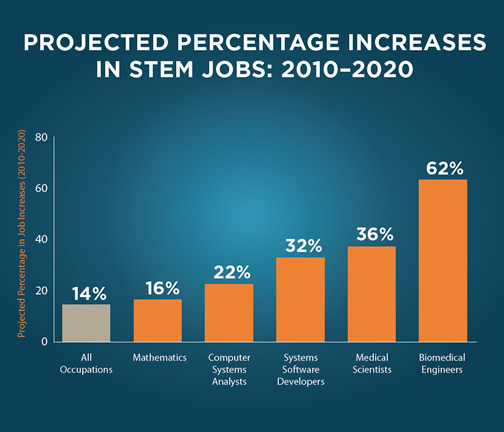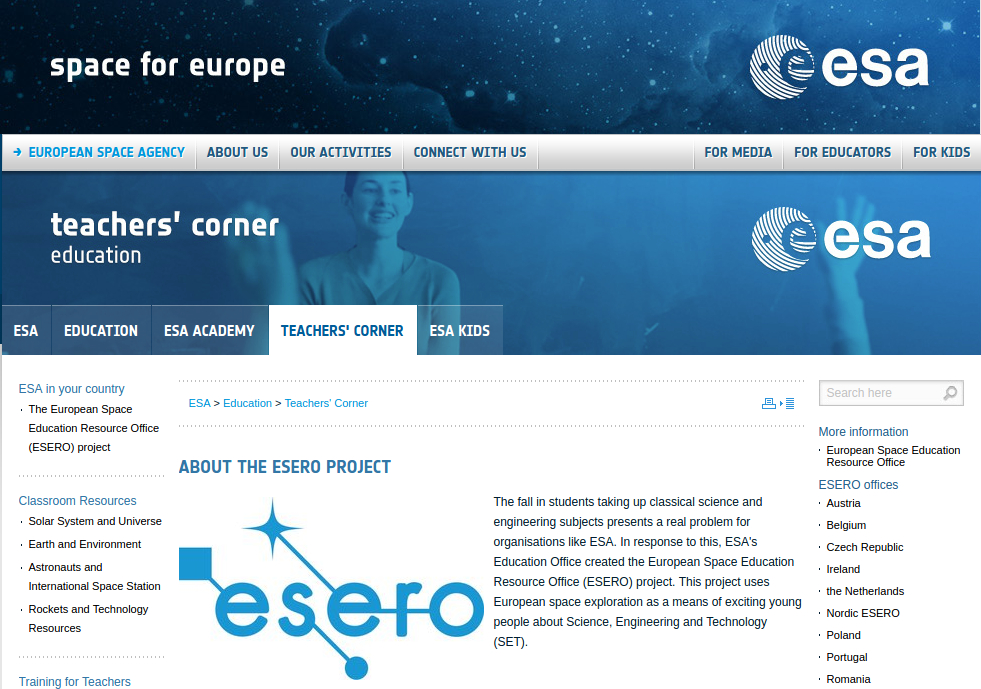The Outer Space as an Educational Motivation
Authors: Melquíades Pérez-Pérez and
Authors information: |

|
Fig.1. Percentage Increases in STEM Jobs
3 Implementation of STEAM Education
STEAM has been a increasing initiative in the last decades and there are policy movements in di erent countries to promote its implementation. Thanks to the rapid development of technologies, new professions appear and the demands for STEAM professionals grows universally.
Integrated instruction is any program in which there is an explicit assimila-tion of concepts from more than one discipline [12]. Integrated STEAM eduation programs apply equal attention to the standards and objectives of two or more of the STEAM elds - Science, Technology, Engineering, Arts and Math. There are di erent ways that a school or class can approach improving math and science education, but most of teachers address the topics as compartmentalized and separate from any other subjects. Students are more con dent and competent in these subjects when teachers help them to approach math and science in inter-active environments that develop communicationd and collaboration skills. This methodology provides tools for students to strengthen learning and contributes to a well-prepared society.
In most e ective STEM and STEAM models the objective is to provide students with the opprotunity to construct new knowledge and problem-solving skills through the process of designing artifacts [7]. They accomplish this through a series of open-ended, hands-on activities related to a thematic topic that ad-dresses important concepts related to STEM disciplines [12]. The main target of this process is involving students in de ning and optimizing a solution for a real-world authentic problem, starting with their precious knowledge and researching on the new knoledge required.
Scientists and engineers approach problem solving optimizing a solution to a problem. Science and math traditional curricula focus on well-de ned problems in which the answer is known, with only one solution, and the focus is on teaching students to get to the right answer. On the opposite side, real-world problems are not exactly de ned and do not have a single right solution. Through an education focused on real-world and authentic problems, students learn to re ect on the process and the learning is more e ective. Through explanation of hypothesis and ideas, they make connections between problem-solving goals and the processes to achieve those goals [9].
Everyone engages in problem solving and use di erent tools and materials. The approach to STEAM or "learning and creating by doing" is founded in construtivist theory [7]. The procedure that students must internalize is:
{ Re ection: Touch down with the problem's context and to provide inspiration for things the student have to investigate.
{ Research: Student research, teacher lessons in science, selected readings and other ways of gathering relevant information. Learning happens mostly dur-ing this stage. During the research phase teachers often lead discussions to determine whether students are developing appropiate conceptual under-standing [12].
{ Discovery: When students take control of the learning process and determine what is still unknown. On this stage it is a powerful strategy to work in groups, to collaborate with fellow students and to build on the strengths of their peers [7].
{ Application: To model a solution that solves the problem. In some cases, students test the model against requirements and the results can suggest them to repeat a previous step [4].
{ Communication: The nal stage is present the model and solution to peers and community. This is a very important stage because they develop com-munication and collaboration skilss and the ability to accept and implement constructive feedback [4].
4 ESERO - ESA Education Program
European Space Education Resource O ce (ESERO) promotes space as a theme to inspire and engage young people in STEM subjects. Space is fascinating to people of all ages, particularly young people. Space is all around us, inspires us in many di erent ways and it is a cross-curricular theme cutting across history, geograpnhy, science, maths, art, literature and even religious education.
ESERO is an education project of the European Space Agency (ESA), co-founded by ESA and by national partners active in the elds on education and space. This project provides a direc link between ESA and the education com-munity (students and educators). This allows ESA to support the education community with information, materials and activities geared towards science, engineering and space exploration.
Reaching millions of students and educators, with di erent languages and education systems throughout Europe is an impossible task for ESA. On this way, ESA decided to set up the ESERO o ces at each Member State, manned by an expert, well integrated into the local education system and networks.
The primary function of the ESERO o ce is to create and grow enthusiasm and excitement for European space exploration among students and inspire the next generation to pursue SET (Science, Engineering, Technology) careers.
Actually there are ESERO o ces in Austria, Belgium, Czech Republic, Ire-land, The Netherlands, Nordic Countries, Poland, Portugal, Romania and United Kingdom. Furthermore, ESA provides a resources store on the Teacher's Corner at ESA webpage (http://www.esa.int/Teachers Corner).

|
Fig.2. Teacher's Corner at ESA webpage
From the link to Teacher's Corner we can access to Classroom Resources clas-si ed in: Solar System and Universe, Earth and Environment, Astronauts and International Space Station and Rockets and Technology); training for teach-ers: Continuous Professional Development, Annual ESA Teacher Workshop and Galileo Teacher Training Programme; Hands-on Projects for Pupils: Cansats, Mission X and SPHERES Zero Robotics; and European Cooperation with oth-ers Scienti c European Institutions: Go-Lab and Science in School.
When we acces to Classroom Resources we obtain a well classi ed database to hundreds of didactic units which connect several subjects and include videos, expert demonstrations and di erent challenges. Before accesing the unit, we can know the subjects connected, the language the unit is wroten and the format of the content.

|
Fig.3. Example of summary of a didactic unit in Teacher's Corner
ESERO uses the outer space and related topics, as well as the genuine fas-cination felt by young people for space to enhance school pupils' literacy and competence in STEM and STEAM related topics. By using the space context to make the teaching and learning of STEM subjects more attractive and ac-cessible, pupils can feel more comfortable and familiar with sciences in general. The ESERO activities help bring STEM subjects within the pupils reach, demol-ishing the misconception that science is only for geniuses. Space, in particular, becomes not just a place of inspiration and future dreams, but also an everyday fact of modern life. [6]. On this way, there also Hands-on Projects for Pupils:
{ European Cansat Competition aimed at secondary school students, mainly addresses technology, physics, and programming curricular subjects. The CanSat activity provides students with the opportunity to have a practi-cal experience sorking on a small-scale space project and promotes teamwork. A CanSat is a simulation of a real sattellite, integrated within the volume and shape of a soft drink can. The challenge for the students is to t all the major subsystems found in a satellite, such as power, sensors and a commu-nication system, into this minimal volume. The CanSat is then launched by a rocket to an altitude of about one kilometer and the mission begins. This involves carrying out a scienti c experiment, achieving a safe landing, and analysing the data collected.
{ Mission X is an international educational challenge, focusing on tness and nutrition, that teaches students how to "train like an astronaut." Teams of students from the United States, Netherlands, Italy, France, Germany, Austria, Colombia, Spain and the United Kingdom are participating in this pilot project, while Japan hosts a modi ed version of the challenge.
In addition to all the programs and resources for students, ESA's Education O ce organises training courses for teachers interested in STEM Education. This courses are developed in three di erent ways:
{ Continuous Professional Development based on space-related resources and space facilities or training sessions during education conferences.
{ Annual ESA Teacher Workshop and organized every year in the Netherlands. One summer workshop in July and another one in October. The course is organized in a four-day programme and the teachers engage in a number of practical training sessions that demonstrate how space can be used as an inspirational and content-rich context for the teaching of STEM curricular subjects at school.
{ Galileo Teacher Training Programme emphasizes in introducing sci-ence teachers to the resources that can be used to teach astronomy and astrophysics. The programme aims to help teachers inspire young people to consider science careers.
5 Conclusions
There are di erent and varied academic articles that demonstrate the bene ts of the STEM and STEAM methodology. The outer space can be an enriching element for the generation of motivational learning situations with which to develop this type of methodologies. The European Space Agency, through its educational o ce, ESERO, o ers a good set of resources that can be used directly in the classroom or even serve as inspiration for the creation of new proposals that can be developed in the classroom through Project Based Learning And Cooperative Learning. In addition, on the ESERO website we can nd links to di erent educational programs and competitions that can also be used as a motivating element for students of all ages.
References
- Beals, J.: Thomas Edison.com http://www.thomasedison.com Retrieved April 30, 2012.
- Butz, W.P., Kelly, T.K. Adamson, D.M., Bloom, G. A., Fossum, D. and Gross, M.E.: Will the Scienti c and Technology Workforce meet the requirements of the federal government? Pittsburgh, PA: RAND, 2004.
- Sixty Fourth Congress of the United States of America. Chs. 113,114. 1917.
- Diaz, D. & King, P.: Adapting a Post-Secondary STEM Instructional Model to K-5 Mathematics Instruction. Clemson: Clemson University, 2007.
- Godik A., Korda, M.:D3.1 Report on desk research. Edu-Artic - Innovative edu-cational program attracting young people to natural sciences and polar research, 2016.
- ESERO Webpage: What is ESERO? http://tiny.cc/ESERO
- Fortus, D., Krajcikb, J., Dershimerb, R.C., Marx, R.W. & Mamlok-Naamand, R.: Design-based science and real-world problem solving. Internatioanl Jorunal of Science Education, 855 - 879, 2005.
- Franklin, B.: Proposals Relating to the Education of Youth in Pensilvania. Philadel-phia, 1749.
- Kolodner, J.L., Camp, P.J.; Crismond, D., Fasse, B., Gray, J., Holbrook, J., et al.: Problem-Based Learning Meets Case-Based Reasoning in the Middle-School Science Classroom: Putting Learning by Design Into Practice. The Jorunal of the Learning Sciences, 495-547, 2003.
- Sander, M.: STEM, STEM education, STEMmania. The Technology Teacher, 68(4). 20-26, 2009.
- Salinger, G. & Zuga, K.: Background and history of the STEM movement. The Overlooked STEM Imperatives: Technology and Engineering (pp. 4-9). Reston, VA: ITTEA
- Satchwell, R. & Loepp, F.L.: Designing and Implementing and Integrated Mathematics, Science and Technology Curriculum for the Middle School. Journal of Industrial Teacher Education:http://scholar.lib.vt.edu/ejournals/JITE/v39n3/satchwell.html, 2010.
- Yakman, G.: What is the point of STE@M - A Brief Overview. STE@M Education Theory, 2010.
 meperper
meperper gobiernodecanarias.org
gobiernodecanarias.org